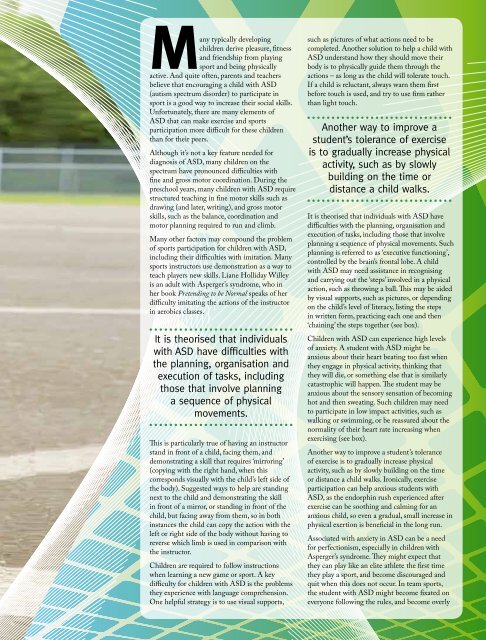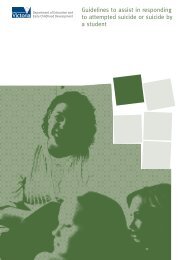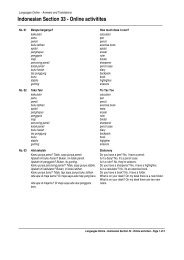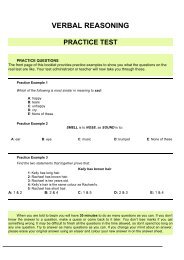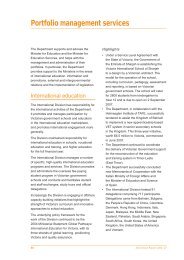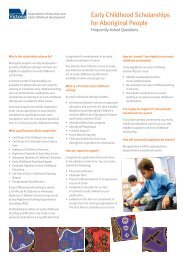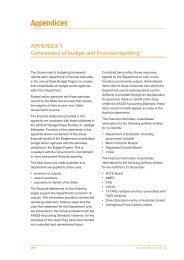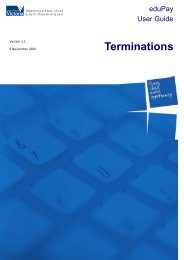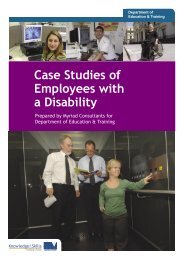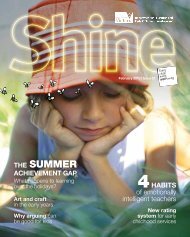November 2009 Vol. 1, Issue 10 (PDF - 16.2Mb) - Department of ...
November 2009 Vol. 1, Issue 10 (PDF - 16.2Mb) - Department of ...
November 2009 Vol. 1, Issue 10 (PDF - 16.2Mb) - Department of ...
You also want an ePaper? Increase the reach of your titles
YUMPU automatically turns print PDFs into web optimized ePapers that Google loves.
Many typically developing<br />
children derive pleasure, fitness<br />
and friendship from playing<br />
sport and being physically<br />
active. And quite <strong>of</strong>ten, parents and teachers<br />
believe that encouraging a child with ASD<br />
(autism spectrum disorder) to participate in<br />
sport is a good way to increase their social skills.<br />
Unfortunately, there are many elements <strong>of</strong><br />
ASD that can make exercise and sports<br />
participation more difficult for these children<br />
than for their peers.<br />
Although it’s not a key feature needed for<br />
diagnosis <strong>of</strong> ASD, many children on the<br />
spectrum have pronounced difficulties with<br />
fine and gross motor coordination. During the<br />
preschool years, many children with ASD require<br />
structured teaching in fine motor skills such as<br />
drawing (and later, writing), and gross motor<br />
skills, such as the balance, coordination and<br />
motor planning required to run and climb.<br />
Many other factors may compound the problem<br />
<strong>of</strong> sports participation for children with ASD,<br />
including their difficulties with imitation. Many<br />
sports instructors use demonstration as a way to<br />
teach players new skills. Liane Holliday Willey<br />
is an adult with Asperger’s syndrome, who in<br />
her book Pretending to be Normal speaks <strong>of</strong> her<br />
difficulty imitating the actions <strong>of</strong> the instructor<br />
in aerobics classes.<br />
It is theorised that individuals<br />
with ASD have difficulties with<br />
the planning, organisation and<br />
execution <strong>of</strong> tasks, including<br />
those that involve planning<br />
a sequence <strong>of</strong> physical<br />
movements.<br />
This is particularly true <strong>of</strong> having an instructor<br />
stand in front <strong>of</strong> a child, facing them, and<br />
demonstrating a skill that requires ‘mirroring’<br />
(copying with the right hand, when this<br />
corresponds visually with the child’s left side <strong>of</strong><br />
the body). Suggested ways to help are standing<br />
next to the child and demonstrating the skill<br />
in front <strong>of</strong> a mirror, or standing in front <strong>of</strong> the<br />
child, but facing away from them, so in both<br />
instances the child can copy the action with the<br />
left or right side <strong>of</strong> the body without having to<br />
reverse which limb is used in comparison with<br />
the instructor.<br />
Children are required to follow instructions<br />
when learning a new game or sport. A key<br />
difficulty for children with ASD is the problems<br />
they experience with language comprehension.<br />
One helpful strategy is to use visual supports,<br />
Xxxx<br />
Shine 15<br />
such as pictures <strong>of</strong> what actions need to be<br />
completed. Another solution to help a child with<br />
ASD understand how they should move their<br />
body is to physically guide them through the<br />
actions – as long as the child will tolerate touch.<br />
If a child is reluctant, always warn them first<br />
before touch is used, and try to use firm rather<br />
than light touch.<br />
Another way to improve a<br />
student’s tolerance <strong>of</strong> exercise<br />
is to gradually increase physical<br />
activity, such as by slowly<br />
building on the time or<br />
distance a child walks.<br />
It is theorised that individuals with ASD have<br />
difficulties with the planning, organisation and<br />
execution <strong>of</strong> tasks, including those that involve<br />
planning a sequence <strong>of</strong> physical movements. Such<br />
planning is referred to as ‘executive functioning’,<br />
controlled by the brain’s frontal lobe. A child<br />
with ASD may need assistance in recognising<br />
and carrying out the ‘steps’ involved in a physical<br />
action, such as throwing a ball. This may be aided<br />
by visual supports, such as pictures, or depending<br />
on the child’s level <strong>of</strong> literacy, listing the steps<br />
in written form, practicing each one and then<br />
‘chaining’ the steps together (see box).<br />
Children with ASD can experience high levels<br />
<strong>of</strong> anxiety. A student with ASD might be<br />
anxious about their heart beating too fast when<br />
they engage in physical activity, thinking that<br />
they will die, or something else that is similarly<br />
catastrophic will happen. The student may be<br />
anxious about the sensory sensation <strong>of</strong> becoming<br />
hot and then sweating. Such children may need<br />
to participate in low impact activities, such as<br />
walking or swimming, or be reassured about the<br />
normality <strong>of</strong> their heart rate increasing when<br />
exercising (see box).<br />
Another way to improve a student’s tolerance<br />
<strong>of</strong> exercise is to gradually increase physical<br />
activity, such as by slowly building on the time<br />
or distance a child walks. Ironically, exercise<br />
participation can help anxious students with<br />
ASD, as the endorphin rush experienced after<br />
exercise can be soothing and calming for an<br />
anxious child, so even a gradual, small increase in<br />
physical exertion is beneficial in the long run.<br />
Associated with anxiety in ASD can be a need<br />
for perfectionism, especially in children with<br />
Asperger’s syndrome. They might expect that<br />
they can play like an elite athlete the first time<br />
they play a sport, and become discouraged and<br />
quit when this does not occur. In team sports,<br />
the student with ASD might become fixated on<br />
everyone following the rules, and become overly


